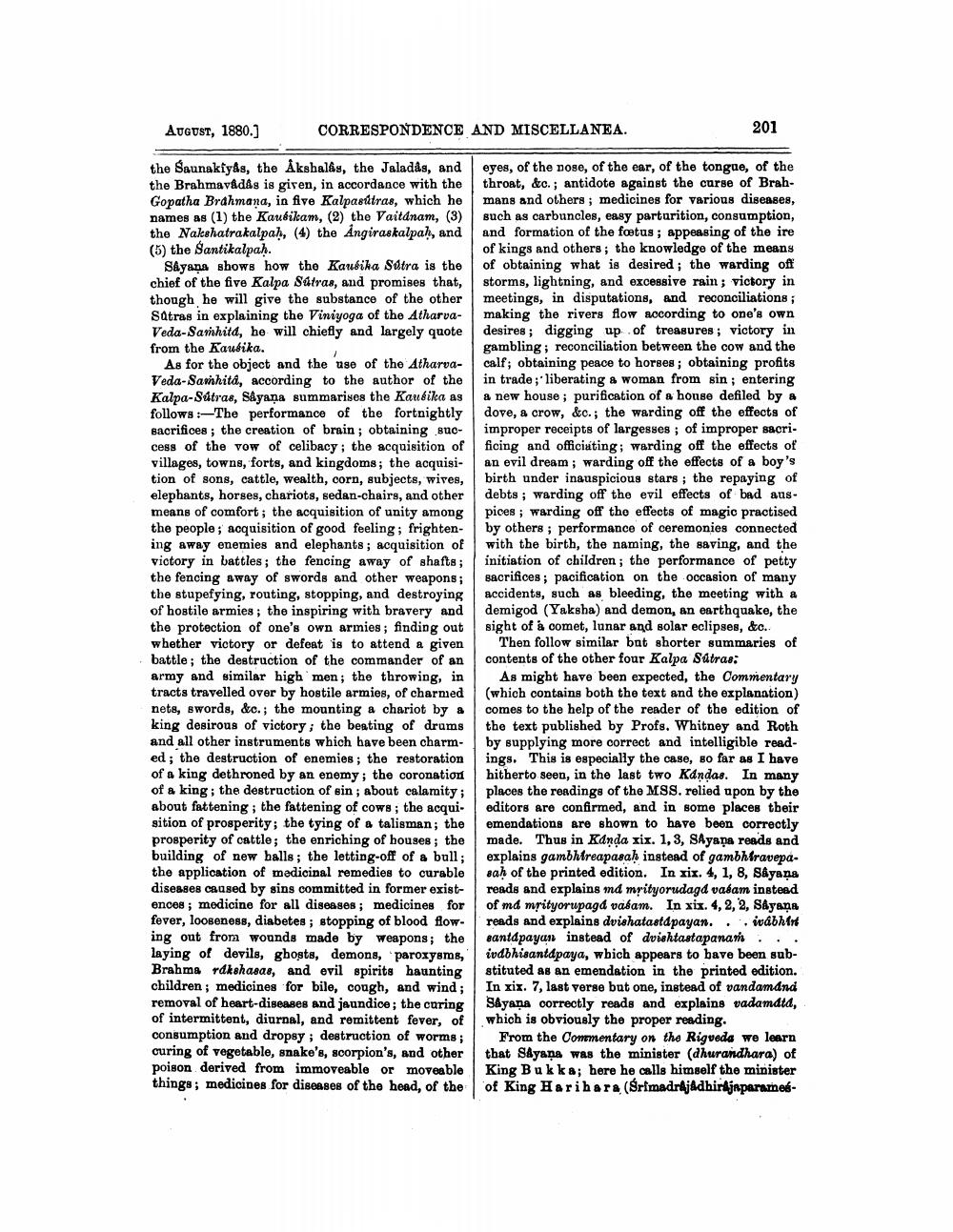________________
August, 1880.)
CORRESPONDENCE AND MISCELLANEA.
201
the Saunakiyås, the Akshalás, the Jaladás, and the Brahmavadås is given, in accordance with the Gopatha Brahmana, in five Kalpasútras, which he names as (1) the Kaubikam, (2) the Vaitanam, (3) the Nakshatrakalpah, (4) the Angiraskalpah, and (5) the Santikalpah.
SAyana shows how the Kaufika Satra is the chief of the five Kalpa Sátras, and promises that, though he will give the substance of the other Satras in explaining the Viniyoga of the AtharvaVeda-Samhitd, he will chiefly and largely quote from the Kausika.
As for the object and the use of the AtharvaVeda-Samhita, according to the author of the Kalpa-Sutras, Sayaņa summarises the Kaufika as follows:-The performance of the fortnightly sacrifices; the creation of brain; obtaining success of the vow of celibacy; the acquisition of villages, towns, forts, and kingdoms; the acquisition of sons, cattle, wealth, corn, subjects, wives, elephants, horses, chariots, sedan-chairs, and other means of comfort; the acquisition of unity among the people; acquisition of good feeling; frightening away enemies and elephants; acquisition of victory in battles; the fencing away of shafts; the fencing away of swords and other weapons ; the stupefying, routing, stopping, and destroying of hostile armies; the inspiring with bravery and the protection of one's own armies; finding out whether victory or defeat is to attend a given battle; the destruction of the commander of an army and similar high men; the throwing, in tracts travelled over by hostile armies, of charmed nets, swords, &c.; the mounting a chariot by a king desirous of victory; the beating of drums and all other instruments which have been charmed; the destruction of enemies; the restoration of a king dethroned by an enemy; the coronation of a king; the destruction of sin ; about calamity; about fattening; the fattening of cows; the acqui. sition of prosperity; the tying of a talisman; the prosperity of cattle; the enriching of houses; the building of new balls; the letting-off of a bull; the application of medicinal remedies to curable diseases caused by sins committed in former existences; modicine for all diseases; medicines for fever, looseness, diabetes; stopping of blood flow- ing out from wounds made by weapons; the laying of devils, ghosts, demons, paroxysms, Brahma rdkshasas, and evil spirits haunting children; medicines for bile, cough, and wind; removal of heart diseases and jaundice; the curing of intermittent, diurnal, and remittent fever, of consumption and dropsy; destruction of worms; curing of vegetable, snake's, scorpion's, and other poison derived from immoveable or moveable things; medicines for diseases of the head, of the
eyes, of the nose, of the ear, of the tongue, of the throat, &c.; antidote against the curse of Brahmans and others; medicines for various diseases, such as carbuncles, easy parturition, consumption, and formation of the fætus; appeasing of the ire of kings and others; the knowledge of the meany of obtaining what is desired; the warding off storms, lightning, and excessive rain; victory in meetings, in disputations, and reconciliations ; making the rivers flow according to one's own desires; digging up of treasures; victory in gambling; reconciliation between the cow and the calf; obtaining peace to horses; obtaining profits in trade;" liberating a woman from sin ; entering a new house ; purification of a house defiled by a dove, a crow, &c.; the warding off the effects of improper receipts of largesses; of improper sacri. ficing and officiating; warding off the effects of an evil dream; warding off the effects of a boy's birth under inauspicious stars ; the repaying of debts; warding off the evil effects of bad aus. pices; warding off the effects of magic practised by others; performance of ceremonies connected with the birth, the naming, the saving, and the initiation of children; the performance of petty sacrifices; pacification on the occasion of many accidents, such as bleeding, the meeting with a demigod (Yaksha) and demon, an earthquake, the sight of a comet, lunar and solar eclipses, &c.
Then follow similar bat shorter summaries of contents of the other four Kalpa Sátras;
As might have been expected, the Commentary (which contains both the text and the explanation) comes to the help of the reader of the edition of the text published by Profs. Whitney and Roth by supplying more correct and intelligible readings. This is especially the case, so far as I have hitherto seen, in the last two Kandas. In many places the readings of the MSS. relied upon by the editors are confirmed, and in some places their emendations are shown to have been correctly made. Thus in Kanda xix. 1, 3, SAyaņa reads and explains gambhfreapasah instead of gambhiravepasah of the printed edition. In xix. 4, 1, 8, Sayana reads and explains ma mrityorudagd vabam instead of md mpityorupagd vašam. In xix. 4, 2, 2, Sayans reads and explains dvishatastdpayan..ivabhiri santapayan instead of dvishtastapanan . . . ivdbhisantapaya, which appears to bave been substituted as an emendation in the printed edition. In xix. 7, last verse but one, instead of vandamand Sayana correctly reads and explains vadamdta, which is obviously the proper reading.
From the Commentary on the Rigveda we learn that SAyana was the minister (dhurandhara) of King Bukka; here he calls himself the minister of King Harihara (Srimadrajadbirljnparames




